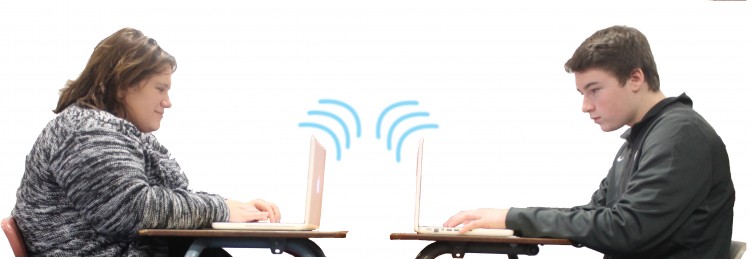A few BSM teachers have evolved in their communication methods with students in a way that matches the evolution of technology. Communication through social media opens up new forms of interaction between teachers and students, changing the form of the relationship completely.
Some believe that the casual nature of this form of communication makes social media sites an inappropriate means of teacher-student interaction. “Twitter is such a casual place for communication amongst a lot of people, and I think teachers and students don’t have a casual relationship in general, so that’s why I think it’s a little weird,” freshman Anna Vigil said.
Despite these beliefs, Dr. Sue Skinner, BSM principal, promotes social media communication as long as it benefits the students and their education. “It’s always a question of boundaries. So, any social media type of communication between students and teachers always has to have the focus of school or teams and clubs,” Dr. Skinner said.
Dr. Skinner does not necessarily promote friending or following students, but she has placed no restrictions to prevent this from occurring, largely because teachers refrain from doing anyway. “You’re choosing to follow Ms. Roushar for educational purposes, but I don’t think [teachers] should feel the need to follow [students’] personal Twitter account,” Dr. Skinner said.
Some teachers however, succeed in using social media effectively without crossing these boundaries. Without being friends with his students, former AP Composition teacher, Mr. Jason Wallestad was still able to easily communicate with them. “We set up a closed group that was the AP Composition class…I think it was the quickest and easiest way to have students keep up with class. The thing I like about Facebook is that it’s one click; you’re simply there,” Mr. Wallestad said.
Ms. Alison Frank, theology teacher, also acknowledges the usefulness and ease of communicating through an easily accessible medium. “It’s one more way to get information for your class. You all have your little smart phones and stuff, so you guys will check that,” Ms. Frank said.
Social media provides an opportunity for teachers to not only convey messages to their classes but to teach lessons outside of the classroom and help with homework as well. “I had everyone add the first sentence of their essay onto a Facebook post, and students were able to like their favorite sentences from the whole class. All of a sudden you have a quick sense of what makes a good lead sentence,” Mr. Wallestad said.
Though some teachers refrain from participating in social media because of the learning curve involved, others find the process simple enough to work with. “I decided that once you figure [Twitter] out, it’s pretty easy,” Ms. Roushar said.
Largely, Twitter serves as a reminder to students about their responsibilities when the teachers cannot remind them in person. “I like [Ms. Roushar’s] tweets, they remind me that I actually have homework. I love the jokes on twitter, even though they are all about chemistry and half the time I don’t get them, I still like them,” junior Samantha Hackathorn said.
Because students frequent social media sites, teachers’ presence on these sites holds students accountable for knowing what work they need to do for class. “[My students] are Twitter addicts, and it’s the best way because then students can’t say, ‘I didn’t get it’ or, ‘I didn’t know we were supposed to wear closed-toed shoes today,” Ms. Roushar said.
Twitter can also serve as a system of encouragement to inspire students to work hard in class. “It’s a way for students to share their success with others when they retweet it,” Mrs. Kari Koshiol, English teacher said.






































![Teacher Lore: Mr. Hillman [Podcast]](https://bsmknighterrant.org/wp-content/uploads/2025/03/teacherlorelogo-1200x685.png)




